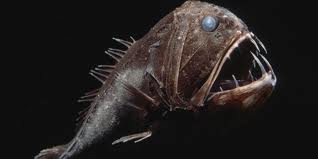
Fangtooth Fish
Fangtooth Fish are ferocious-looking deep-sea beryciform fish of the family Anoplogastridae (sometimes spelled “Anoplogasteridae”). With a circumglobal distribution in tropical and cold-temperate waters, the family contains only two very similar species, in one genus, with no known close relatives: the common fangtooth, Anoplogaster cornuta, found worldwide; and the shorthorned fangtooth, Anoplogaster brachycera, found in the tropical waters of the Pacific and Atlantic Ocean.
Fangtooth Fish Description
The Fangtooth Fish head is small with a large jaw and appears haggard, riddled with mucus cavities delineated by serrated edges and covered by a thin skin. The eyes are relatively small, set high on the head; the entire head is a dark brown to black and is strongly compressed laterally, deep anteriorly and progressively more slender towards the tail. The Fangtooth Fish fins are small, simple, and spineless; the scales are embedded in the skin and take the form of thin plates. As compensation for reduced eyes, the lateral line is well-developed and appears as an open groove along the flanks.
In adults, the largest two fangs of the lower jaw jaw are so long that the fangtooths have evolved a pair of opposing sockets on either side of the brain to accommodate the teeth when the mouth is closed. According to BBC’s Blue Planet- The Deep -, the Fangtooth Fish has the largest teeth of any fish in the ocean, proportionate to body size. The juveniles are morphologically quite different – unlike the adults, they possess long spines on the head and preoperculum, larger eyes, a functional gas bladder, long and slender gill rakers, much smaller and depressible teeth, and are a light gray in colour. These differences once caused the two life stages to be classed as distinct species, with one in another genus; Caulolepsis. Fangtooth Fish are among the deepest-living fish found as far as 5,000 metres (16,400 feet) down.







